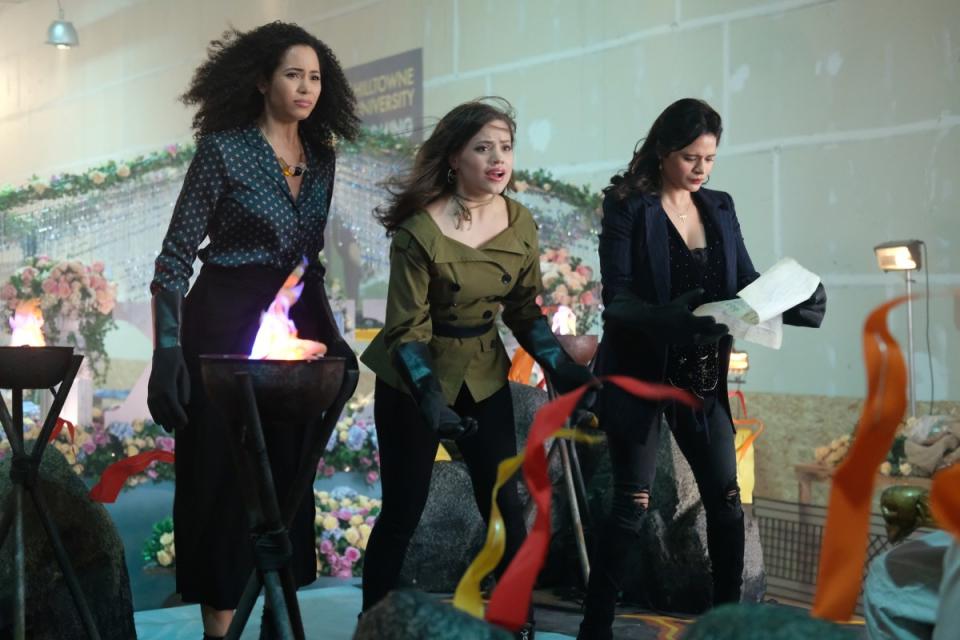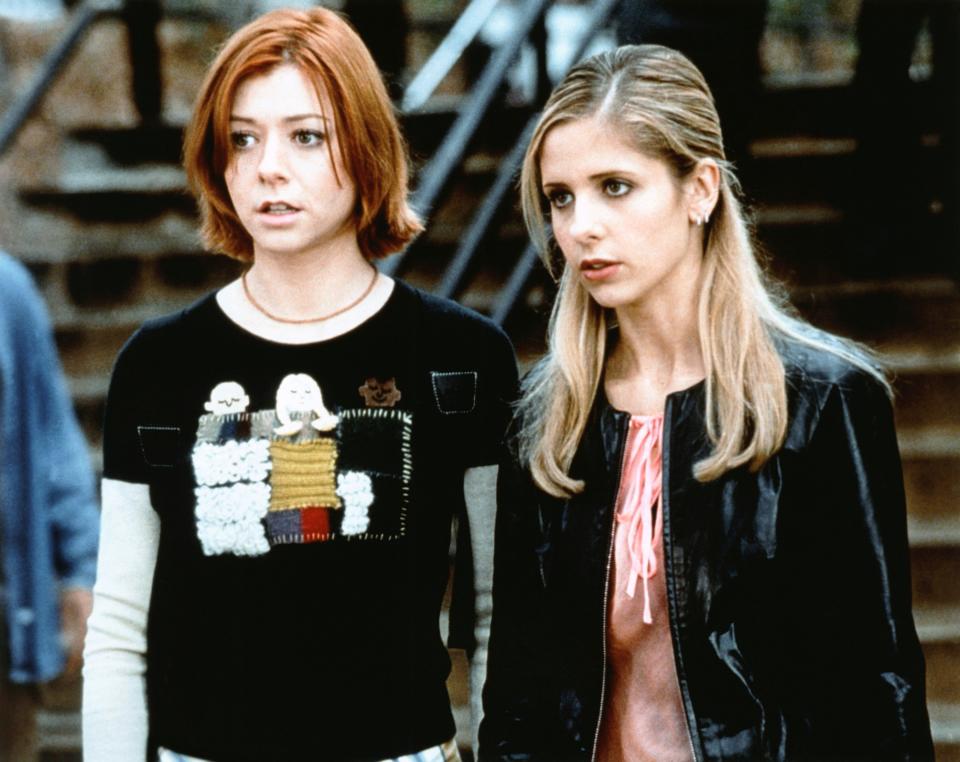The Resurgence of Witches in Pop Culture, Like Sabrina, and in "AHS Coven" and "Charmed," Reflects Women in the Real World
Every year, the first blustery day of October comes along with a wave of Halloween tidings — pumpkin spice lattes, decorative gourds, and cozy mugs emblazoned with phrases like “Trick or Treat Yourself.” Following suit, the entertainment industry serves up jump scares at the theater and 31 days of spooky programming on television. But 2018's Halloween season came with an extra helping of witchcraft, and the reason appears to go way beyond a spooky tradition.
As of Halloween 2018, there were three concurrent TV series centered on witches that had everyone talking: Charmed on The CW, Netflix’s Chilling Adventures of Sabrina, and the witch-centric season of American Horror Story: Apocalypse on FX. In movie theaters, audiences got a taste of a murderous coven masquerading as a ballet company in Suspiria, starring Dakota Johnson. Add to that the upcoming ABC adaptation of Bewitched and British import A Discovery of Witches, set to arrive in early 2019, and it seems witches are having a moment, one that’s not confined to the only month in which it’s acceptable to eat candy corn.
This wave of ritual magic might have something to do with everything else that's happening around this hallowed fall holiday. It’s easy to see the plots of the three most prominent witch narratives on television as direct responses to painful real-world misogyny (see: Louis C.K.’s “comeback,” the Kavanaugh hearings, and the lenient sentencing of Bill Cosby). We are living in a dunk tank of female rage — there’s a reason prominent feminists are releasing books with titles such as Good and Mad and Rage Becomes Her this year — and this wave of witchiness appears to be a manifestation of that environment. Witchcraft might present itself as the pitch-perfect expression of female rage and frustration.
“What's happened, in part because of the movement in the 1960s, the women's movement, and women's spirituality, is that witchcraft is now being seen as women's empowerment, not women's evilness,” says sociologist and author of A Community of Witches: Contemporary Neo-Pagans and Witches in the United States, Helen Berger, who conducted a 10-year study on young women participating in neo-pagan rituals and witchcraft. “I think that the way that plays out is the way in which the women can speak about it and participate, particularly these girls, young women, [and] could think about being empowered.”
As part of her research, Berger interviewed young women practicing witchcraft across three countries (the U.S., England, and Australia), and says that a possible reason the idea of witchcraft might appeal to young women is the open nature of the religion at the heart of it. “I think, particularly for young people, it has a real edge to it being outside,” she says. “And I think it does give them a feeling that practicing magic gives you a sense of control.” The series and films contributing to this witchy new trend might be avenues of escapism more than they are training manuals for future real-life witches, but that sense of longing for control, especially among young women, is a driving force through many of the narratives.

In the Charmed pilot, The CW’s reboot of the beloved series, three sisters discover that they are actually incredibly powerful witches. By the end of the first episode, the trio vanquishes a college professor guilty of being a sexual predator, who turns out to be a misogynist demon, a victory that is heightened by the fact that he’s been wielding his power at the university to hurt women for decades. The entire episode plays like an obvious 2018 fantasy, wherein the solution to all our problems is harnessing secret powers we didn’t know we had to rid the world of toxic men in authority, one frustrating scenario at a time.
Over on American Horror Story, we find the comeback of Sarah Paulson’s coven from season 3 (Surprise, bitch!) opposing the most toxic male to ever walk the earth: Michael Langdon, aka the literal Antichrist. Paulson returns as the Supreme, Cordelia Goode, and becomes the avatar for a reverse sexist plot in which the reign of witches is threatened by the idea that a man (Langdon) could take control by becoming the new Supreme — a role exclusively held by women for generations. It should be noted that even in a world in which men frustrated by women in leadership positions have the moral high ground, a faction of warlocks still manages to align itself with a man who will bring about the end of days. The season has been bubbling up for a final showdown with the coven of witches, including Billie Lourd’s Mallory, who seems to have the potential power to defeat Langdon and save the world.
Lastly, there’s Chilling Adventures of Sabrina, which is so far removed from the '90s show starring Melissa Joan Hart that the series can hardly be called nostalgic (it’s actually adapted from the comics). Instead, this darker, bloodier version of Sabrina Spellman’s escapades introduces a world in which the misconception that witchcraft, paganism, and Wiccan rituals are about devil worship is indulged to create a brewing battle for ultimate control. The Spellman's coven is ruled by the devil himself, the Dark Lord, who maintains a relentless agenda to make Sabrina his faithful mistress. But there’s a twist: In this terrifying world, Sabrina plans to crawl deeper into the clutches of the Dark Lord’s dominion while sussing out a way to remove his power and take him down. A series about a young, determined, tenacious woman diving headfirst into a dark, male-dominated political world that constantly threatens to make her a servant rather than a leader so she can fight for the greater good? Hmm, sounds familiar.
“A general sense of powerlessness in a chaotic and competitive society, along with a revived interest in forms of feminism that don’t care who they frighten, may explain the growing appeal of hedge magic as a cultural aesthetic as much as a practice,” writes journalist and activist Laurie Penny in her December 2017 exploration of the rising interest in witchcraft. “The craze for witchery displays an encouragingly wide understanding that for social change to happen someone has to feel threatened. The paraphernalia of skulls and guts and ravens are merely a uniform that declares intent. I am not a nice, compliant creature, not a princess in training. I am something else. Something darker. There are more like me. Best beware.”

Exorcise Your Demons
If Penny’s assertion holds, it makes sense that when women’s resistance is at a fever pitch (as it was in the '60s, the '90s, and now) and women are seeking empowering stories that allow them to control their own narratives, stories about witchcraft seem to become more popularized.
Control and empowerment are key parts of these witchy narratives, but there’s also a strong sense of community that comes from tales about witches and covens — an element that is not only essential in large cultural movements, but one that became apparent when witchcraft gained popularity in the '60s. “There has been attention given to witchcraft for years, going back into the '60s when women were bringing attention to some of the challenges we were facing in the workforce,” says Janine Nelson, a high priestess in the majestic tradition and spokesperson for the Covenant of the Goddess, one of the oldest and largest Wiccan advocacy groups in the U.S. “They found a comraderie or a comfort within Wicca because it was matriarchal in its focus rather than patriarchal.”
Further to Nelson’s point, when second wave feminism took hold in the early '60s, covens and witch imagery came with it — in pop culture and the real world. Bewitched, a series about a beautiful, kind witch, became a wildly popular TV show, countering the traditionally grisly, evil image of witches that had prevailed in film and television. On the activism side, there was a group of women who, in 1968, founded an organization called W.I.T.C.H.. The name had different definitions, but started out as the Women’s International Terrorist Conspiracy from Hell, which begat small covens all over the country who organized to hex male-dominated organizations and groups, including Wall Street.
During the early '90s, when many believe the third wave of feminism began, perhaps prompted by a woman leveling sexual harassment allegations against a powerful man (Anita Hill against then-Supreme Court nominee Clarence Thomas), popularized witchcraft seemed to rise again. With ABC’s Sabrina the Teenage Witch, teens were served up a plucky teenage witch, struggling to own her newfound power. There was also Buffy the Vampire Slayer, whose main character has been hailed as a third wave feminist icon. The cult classic also prominently featured Buffy’s best friend, Willow, a powerful witch who was the lynchpin in almost all of Buffy’s plans to best evildoers. The original Charmed gave voice to women fighting toxic masculinity when its first season focused largely on the Halliwell sisters battling sexual predators and other bad men. On the big screen, we saw the now-classic pairing of Sandra Bullock and Nicole Kidman as two sister witches attempting to rid the world of an abusive, alcoholic nightmare of a man in Practical Magic; the teenage-witchcraft fever dream that is The Craft; and even a Winona Ryder-starring adaptation of The Crucible (the classic Arthur Miller play about the Salem Witch Trials).

BUFFY THE VAMPIRE SLAYER, (from left): Alyson Hannigan, Sarah Michelle Gellar, 1997-03. TM and Copyr
Sure, realistically speaking, '90s witches (and the new set of witches) likely became a trend because studios and TV networks realized that it was financially beneficial to deliver the witch stories women crave, similar to the vampire craze that hit pop culture around 2009. But even in the case of the vampire wave — a trend that largely appealed to women and often found female characters in liberating, hypersexualized encounters with provocative fanged partners — the trend just happened to coincide with a cultural shift that found more women engaging in casual sex for pleasure.
Now we’re seeing a cultural shift in which women are using the magic of their rage to influence real-world politics. As witches parade across our big and small screens, some women are self-identifying as “basic witches” and referring to their friends as their “coven” (among other aesthetically witchy pursuits), and there’s even a growing group of 13,000 “Resistance Witches” who gather to hex President Donald Trump on a monthly basis. Sure, witches are a profitable trend, and helpful for selling more cute Halloween goods at Target, but it stands to reason that any trend, witch or non-witch, has something to do with how audiences are feeling about the world at a particular moment. This is why feminism became a bankable “trend” as early as 2013, and why TV and movies are having what The Guardian called an “a-wokening”, as equality and social justice continue to dominate cultural conversations. These trends are profitable because they fit the social consciousness of the audience at which they’re aimed.
The coven of witchy characters in popular culture almost certainly goes deeper than a seasonal dedication to all things spooky. If past trends have taught us anything, when the witches arrive en masse, it’s an almost direct reflection of the ills society is leveling against women. And, boy, are there ills aplenty right about now.
Related: This Chilling Adventures of Sabrina Clue Means Sabrina Might Be Related to Madison Montgomery
Get the Teen Vogue Take. Sign up for the Teen Vogue weekly email.

